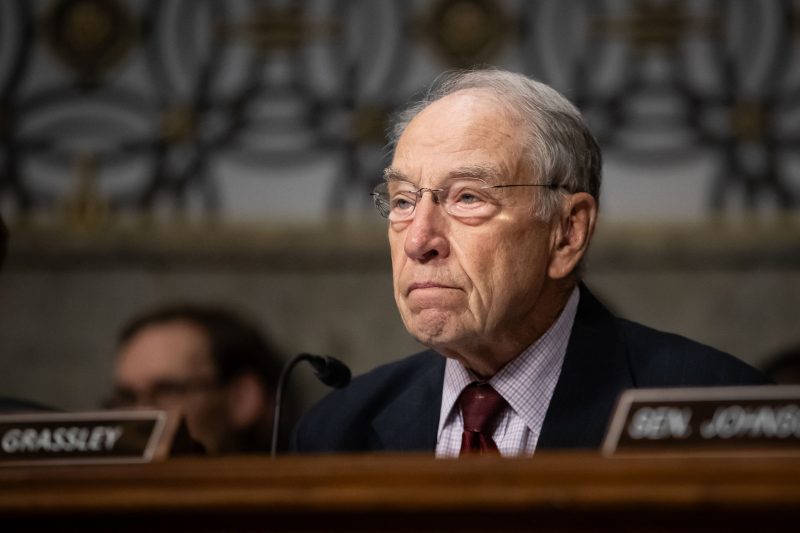New Lines of Attack Form Against the Affordable Care Act

The Affordable Care Act is back under attack. Not as in the repeal-and-replace debates of yore, but in a fresher take from Republican lawmakers who say key parts of the ACA cost taxpayers too much and provide incentive for fraud.
Several House Republican leaders have called on two watchdog agencies to investigate, while Sen. Charles Grassley (R-Iowa) fired off more than half a dozen questions in a recent letter to the Centers for Medicare & Medicaid Services.
At issue are the ACA’s enhanced subsidies, put in place during the covid-19 pandemic as part of economic recovery legislation. Grassley said in a recent news release that the subsidies “left Obamacare, a program already riddled with problems, wide open to new waste, fraud and abuse.”
While potential fraud in government programs has always been a rallying cry for conservatives, the recent criticisms are a renewed line of attack on the ACA because repealing it is unlikely, given that more than 21 million people enrolled in marketplace plans for this year.
“I see what’s happening right now as laying the groundwork for the big fight next year,” said Debbie Curtis, a vice president at consulting firm McDermott+.
The enhanced subsidies are set to expire in late 2025. Without them, millions of Americans would likely see their premiums go up.
But the debate will also likely draw in other issues, including Trump-era tax cuts, which also must be addressed next year. Also potentially in play are other aspects of the ACA, including a special year-round enrollment period and zero-premium plans for low-income consumers.
Much of what eventually happens will depend on the makeup of the Senate and House, as well as control of the White House, after the November elections.
“The fate of the enhanced tax credits is dependent on the Democrats holding some majority in Congress and/or winning the presidency and is also tied inextricably to the Trump tax cut expiration,” said Dean Rosen, a partner at Mehlman Consulting and a former senior Republican congressional staffer. That’s because both sides have incentive to extend all or part of the tax cuts, but each will want some kind of compromise on other issues as well.
The growing outcry by Republicans about the subsidies goes hand in hand with a controversial recent report from a conservative think tank that estimates millions of people — or their brokers — may be misstating their incomes and getting the most generous ACA subsidies.
The Paragon Health Institute report estimates that the number of people who enrolled in ACA coverage for this year who projected they would earn between 100% of the federal poverty level and 150% — amounts that qualify them for zero-premium plans and smaller deductibles — likely exceeds the number of people with that level of income, particularly in nine states.
It recommends several changes to the ACA, including letting the enhanced subsidies expire, increasing repayment amounts for people who fail to project their incomes correctly, and ending the Biden-backed initiative that allows very low-income people to enroll in ACA coverage year-round rather than having to wait for the once-a-year general open enrollment period.
The Paragon report was cited by both Grassley and the House GOP lawmakers in their letters to government overseers. It also notes what they consider a related concern: ongoing problems of unscrupulous, commission-seeking agents enrolling people in ACA coverage or switching their plans without their permission, often into highly subsidized plans. KFF Health News uncovered the enrollment and switching schemes in the spring.
Some critics, though, question how the Paragon analysis was done.
For instance, Paragon’s findings rely on two unrelated data sets from different years. Combining them makes many people who are eligible for subsidies appear to be ineligible, said Gideon Lukens, a senior fellow and director of research at the Center on Budget and Policy Priorities. “The analytic approach is not careful or sophisticated enough to provide accurate or even meaningful results.”
Paragon President Brian Blase, a former senior Trump administration official and a co-author of the report, said it used publicly available data that others could use to confirm its results.
Paragon’s recommendations also drew mixed reactions.
Sabrina Corlette, a co-director of the Center on Health Insurance Reforms at Georgetown University, said they “would make coverage less affordable, disproportionately affecting low-income people, and that’s the opposite of the goals of the ACA.”
Another ACA expert, Joseph Antos of the conservative American Enterprise Institute, agrees with one of the recommended fixes: changing the structure of the subsidies to limit zero-premium plans.
“Giving health insurance away is the problem,” said Antos, who said it is probably contributing to the unauthorized switching by some rogue brokers, who know if they sign someone up for a free plan without their permission, they’re unlikely to get caught for a while because the person won’t get monthly bills.
Another potential solution to people misstating their income is that “the seven or eight states that still haven’t expanded Medicaid should do that,” Antos said. The expansion would open Medicaid eligibility to more people who earn less than the poverty level, reducing the incentive to overestimate their income to qualify for ACA subsidies.
Among other things, the subsidies are larger now for low-income enrollees. For example, families at the poverty level or just above it ($30,000 to $45,000 for a family of four) can currently qualify for coverage with no monthly premium, whereas before they would have had to pay 2% to 4% of their annual income toward such a plan.
President Joe Biden has pushed to make the subsidies permanent and has often touted the record enrollment in ACA plans under his watch. Across all income groups, nearly 20 million people out of 21 million ACA enrollees this year got at least some subsidy, according to a KFF report.
Subsidies, also called premium tax credits, are generally paid directly to health insurers, and applicants must estimate their income for the coming year to qualify.
Those who incorrectly project their incomes — possibly because they work irregular retail hours, are self-employed and give a best guess of business, or get an unexpected raise or a new job — must pay back all or part of the subsidy, on a sliding scale linked to income.
The cost of the enhanced subsidies has been sharply criticized by some GOP leaders after the Congressional Budget Office recently estimated that making them permanent would add $335 billion to the federal budget deficit over 10 years.
Democrats have pointed to another recent CBO report estimating extending the Trump-era tax cuts would add $4.6 trillion to the deficit over 10 years.
The enhanced subsidies “cost a lot less than that and it’s actually helping people,” Curtis said.
Ultimately, “every health care debate comes down to money,” said Larry Levitt, executive vice president for health policy at KFF, a health information nonprofit that includes KFF Health News. “There is a trade-off here. Millions of people have gotten coverage and more affordable premiums due to these enhanced subsidies, but extending them would cost the government a lot of money.”
Despite the attention paid by some GOP lawmakers to the fraud concerns, many political observers say they don’t think they will play a direct role during the election campaigns of either party.
“For Republicans, they’ll stay away from health care period. It is not a winning campaign issue for them,” Curtis said. “With Harris’ campaign, we will see a continued drive for affordable coverage being key, particularly drug costs. In neither party will you hear much about the importance of extending the enhanced subsidies. It’s too complicated.”
KFF Health News is a national newsroom that produces in-depth journalism about health issues and is one of the core operating programs at KFF—an independent source of health policy research, polling, and journalism. Learn more about KFF.
USE OUR CONTENT
This story can be republished for free (details).








